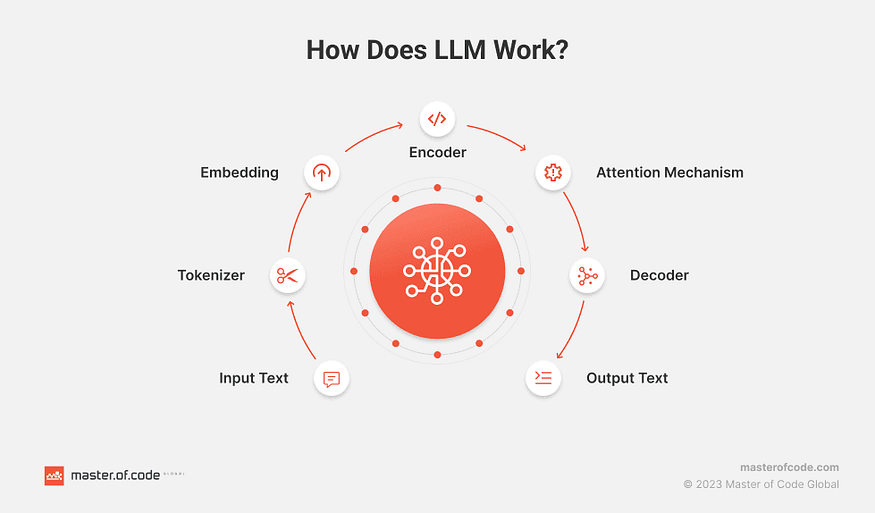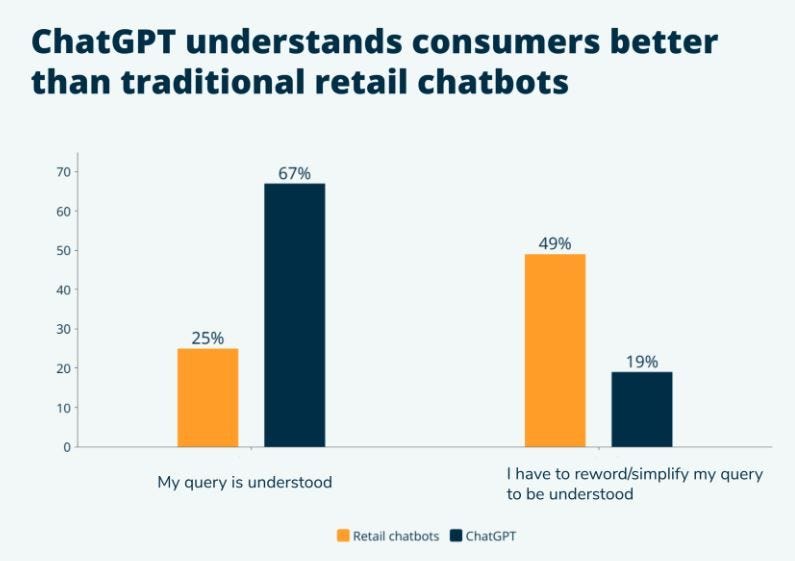Beyond Chatbots: Broad Applications of Large Language Models
Think of a world where artificial intelligence (AI) not only chats with you but also writes your reports, translates thousands of languages, organizes plans for teaching schedules, and even codes like an experienced software developer. We are now living in times where all these tasks can be simplified by Large language models that are trained on vast datasets. As per Springapps, nearly 67% of organizations utilize generative AI products that depend on large language models (LLMs) to process human language and create content. To understand how impactful LLMs are going to be in the next few years, let us dive into the applications of LLMs and areas where they have already taken over. At the same time, we’ll explore their potential to shake the traditional principles of current industries and change the future of technology and innovation.
What are Large Language Models (LLMs)?
Large Language Models (LLMs) aka deep neural networks are machine learning models that are trained on large sets of data using artificial intelligence. They can interpret, process, and predict any kind of information. These deep-learning algorithms are trained using data accumulated from millions of gigabytes worth of text. To understand how characters, words, and strings function collectively, Large Language Models use deep learning to distinguish between types of content without the help of any human interference and produce the output. They are designed to act and behave like any normal person.

Leap from traditional chatbots to LLMs
Traditional chatbots are bounded by limited scripts and boring responses. They easily lose the interest of any user. On the other hand, advanced language models can respond to prompts with better accuracy and predict what the user wants, by analyzing vast amounts of datasets and generating contextually rich dialogues. This makes the conversations more interactive and fun, as LLMs bring a natural and personalized learning approach to human interaction.

What is an LLM capable of?
1)Text Generation: Versatile Creative Writing
LLMs like GPT-3 have amazed people worldwide with their ability to understand context and generate human-like text for tasks like translation and creative writing. These models rely on the transformer architecture and resort to decoding strategies like greedy search, and stochastic methods like temperature sampling. Speculative decoding is a technique used to speed up the text generation process by predicting tokens with a smaller model before validating them.
2)Text Summarization: Condensing Complex Information
LLMs are fantastic at text summarization using both abstractive and extractive methods. Abstractive summarization distills essential information to create a new summary, like highlighting benefits and research gaps. While extractive summarization selects key sentences directly from the text by focusing on ongoing research objectives like health promotion and long-term effects.
3)Machine Translation: Bridging Language Divides
Effective communication is hindered by language and cultural barriers. Machine translation has made a ground-breaking breakthrough in breaking these barriers. In earlier times, systems used to rely on hand-written rules to map words and phrases from one language to another. But in 2024, these systems use statistical models trained in various languages that can easily understand and interpret textual information. LLMs can also adjust sentence structure and generate creative text formats.
4)Question Answering: Providing Insightful Responses
Solving the limitations of traditional keyword-based searches, Generative Question answering (QA) uses LLM models to comprehend and generate contextually rich responses. By integrating vector databases and advanced embeddings, these systems interpret queries, understand context, and retrieve relevant information, By doing this, they are able to act more thoughtfully and make a person feel understood.
5)Code Generation: Automating Coding Task
Tasks like code composition, testing, and debugging can be automated without any human intervention with LLMs. There are plenty of tools like AgentCoder, AlphaCodium, and GPTEngineer, that are already in the market making the lives of developers easier. Large Language Models (LLMs) like Llama Code have brought us closer to the dream of not having to do code generation manually and automating every programming challenge.
Use-cases of LLMs in various Industries
1)Education: Personalized Learning and Content Creation
With LLMs, educators can organize lesson plans and provide individualized feedback to their students. Automation of processes like grading and lesson planning frees up valuable time for instructors to focus on teaching. Interactive educational tools like simulations, games, and tutorials give an attractive and engaging learning experience to students and help them in their academic journey. There are quite a few use cases for LLMs in education, ranging from personalized learning experiences to efficient content creation for the all-around support of students.
2)Customer Service: Enhanced Chatbots and Sentiment Analysis
Customer service chatbots, the predecessors of modern LLMs, have long been valued for their ability to provide instantaneous responses. NLP chatbots offer a personalized understanding of human speech. Effective training remains crucial to avoid robotic and ineffective responses. Beyond chatbots, the integration of LLMs in sentiment analysis introduces a new dimension to customer service chatbots development helping businesses to gauge public opinion, market dynamics, and customer preferences with better accuracy.
3)Content Creation: Overcoming Writer’s Block
Humans struggle to come up with creative ideas while writing and find it difficult to express their thoughts in clear words. Having creative AI tools by your side to suggest ideas or give direction to your thoughts can be of great help. By using NLP and ML, powerful AI assistants can improve the grammar, tone, and overall content creation along with the flow of writing. Use cases of LLMs in content creation will influence the way content is produced. This will help content writers in dodging the time-consuming writer’s block.
4)Scientific Research: Accelerating Data Analysis and Hypothesis Generation
For users who are not used to working with complicated databases, LLMs simplify data retrieval and help them ask straightforward questions, like knowing the figure of sales growth in the last quarter as compared to the previous quarter. There are plenty of applications of LLMs in scientific research as they can also rapidly generate ground-breaking and innovative research ideas, free from human biases and traditional constraints. They provide fresh perspectives and useful insights in the early stages of scientific inquiry.
What lies ahead for LLMs?
1)Impact of LLMs on Society
Artificial intelligence(AI) will soon become a part of our daily lives. It will change the way we think, communicate, work and learn. LLMs are freeing up human labor by automating tasks with their logical approach to problem-solving. This is an indirect threat to humans, as they could replace us in less creative and routine tasks. Companies are now looking for individuals who have skills like critical thinking, creativity, and emotional intelligence, and someone who knows how to make the best use of Artificial intelligence (AI) and Machine learning.
2)Ethical AI Considerations in LLM Development and Usage
To prevent the manipulation of the output generated by LLM and mitigate AI fraud, impenetrable security measures need to be implemented in intrusion detection systems. For more information on cyber frauds and how to mitigate them, please read our blog “Cybersecurity in Fintech: From Phishing to AI Fraud.” Various LLMs are carelessly trained with unrefined data from the internet. This data reflects upon the bad outputs of the model. The content or language it may include could be very toxic or discriminatory. To deal with this, models must be trained with diverse and representative datasets. This will also push the narrative of promoting fairness and inclusivity in ethical AI responses. Emotional intelligence will play a huge role in solving the black-box problem of how LLMs arrive at their conclusions.
3)What caliber does LLM hold?
LLMs have found better ways for us to interact with machines. They are designed in a way that they can mirror and mimic the structure and functioning of an actual human being. Despite hurdles like hallucinations and the need for responsible prompt engineering, they continue to win the vote of confidence of a wide range of industries that won’t miss the golden chance to invest in this technology, gain a quick headstart, and get ahead of their competitors.
The next big milestone in LLM development
The future of technology heavily depends on the advancements made in LLM development. Significant effort in LLM development projects will be dedicated to fine-tuning and specializing existing versions of LLMs. For example, versions of the model optimized for legal or medical language, or for software engineering will be developed and used. Extending LLMs to handle text together with images, audio clips, or other sensorimotor inputs, will help the model to reason jointly about the meaning of both the structured and unstructured information. According to Globe Newswire, the global market for LLMs is projected to expand at an annual growth rate of 33.2%. The education sector, in particular, will benefit notably from the use cases for LLMs in education. Optimizing LLMs for the deployment of edge devices (e.g., mobile phones, and robots) will improve the privacy of such devices. Beyond chatbots, LLMs will be able to collaborate with other AI models, such as computer vision or reinforcement learning models, to achieve more comprehensive coverage of the desired functionality and solve more complex problems Other directions where LLMs will set their foot are ensemble learning, hyperparameter optimization, and few-shot learning.

As LLMs evolve, they come with promising opportunities for growth in terms of creativity and innovation. So it makes it very essential to partner with industry leaders like us to help you grow in this market. Our team of experts in machine learning and LLMs develops solutions that fulfill the expectations of our B2B and B2C customers. Whether you are looking for task automation, intelligent chatbots, or software to create personalized education plans, we are proficient in delivering scalable and fully functional projects. Collaborating with Webelight Solutions would give you a boost in the AI race and change the way you work, learn, and interact with technology. By making positive use of machine learning models, we can contribute to the field of science and technology and guide our society toward a future where human potential is amplified, not replaced. With that thought in mind, let us embrace the innumerable possibilities of LLM with optimism and ensure that they serve as tools for progress and enrichment for all. So what are you waiting for? Get started with Webelight Solutions today and lead your industry with the latest and most advanced AI technology.
.jpg)

Comments
Post a Comment